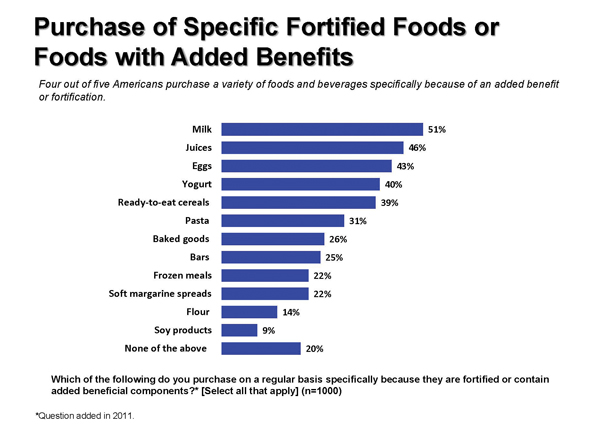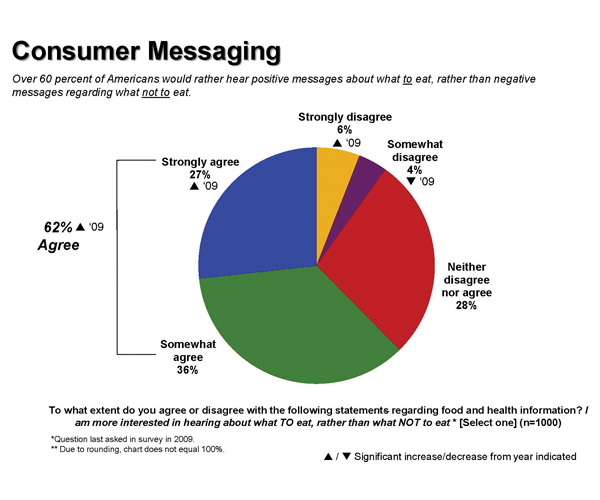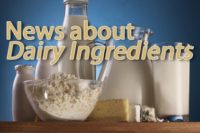
According to Healthy 50+ Americans: Trends and Opportunities in the Emerging Wellness Market by Packaged Facts, a division of MarketResearch.com, Rockville, Md., changes in thinking about what it means to get old have occurred alongside a rising concern by consumers of all ages about doing what it takes to improve their health and wellness.
“As Boomers turn 50 and enter their 60s, they carry with them a firm belief that getting older means getting better. Many look at aging simply as another life stage filled with opportunities for reinventing themselves and experiencing new possibilities for personal growth rather than as a signal to wind down their lives,” says Don Montuori, publisher of Packaged Facts.
The report defines “healthy 50-plus consumers” as the 26 million Americans 50 years and older who are pursuing a wellness regime that includes healthy eating and regular exercise activities. Food companies have begun to aggressively target this demographic, in particular with products enhanced with ingredients that assist in slowing the aging process. Many such products command a premium, but this is likely not a problem, as exclusive data from a February 2011 Packaged Facts’ consumer survey indicate that this demographic is very willing to pay a premium when purchasing “better-for-you” grocery products.

Gerontologists define “successful aging” as when a person experiences only a minimal decline in physical and mental function with age, and is able to maintain an active, productive and rewarding life, followed by a relatively short period of decline, or none at all, prior to death. Unfortunately, genetic endowment and degeneration of the body are immutable. But proper nutrition, which includes nutrient-dense and enhanced dairy foods, can make the road to the inevitable more pleasant.
With a growing aging population that would rather hike a mountain than watch television game shows on the living room rocker, product developers are formulating foods that provide these consumers the key nutrients they need in order to successfully age. Due to increased expectations surrounding standards of living and improved productivity later in life, the marketplace has seen an increase in anti-aging foods and beverages.
Before heading to the lab to concoct a youth serum, formulators and marketers must agree on the specific anti-aging benefit the product will promise to deliver and they should focus on ingredients that provide this specific anti-aging benefit. Sometimes it is possible to make a health claim to promote the product’s benefit(s), but for the most part, an educated consumer will understand content or inclusion statements on a product packaging.
For example, considerable scientific evidence indicates that nutrients such as lutein, zeaxanthin and the omega-3 fatty acid docosahexaenoic acid (DHA) can play a beneficial role in maintaining eye health. Research published in the December 2004 issue of the Journal of the American College of Nutrition indicates that foods rich in lutein and zeaxanthin, two nutrients classified as xanthophyll carotenoids, can help prevent common causes of age-related blindness, including cataracts and age-related macular degeneration. And according to research published in the March 2001 issue of Progress in Lipid Research, DHA is concentrated in the retina and membranes of the eye.
In addition to the eye health connection, omega-3s have been shown to have a beneficial effect on the heart. Specifically, DHA and eicosapentaenoic acid (EPA) are key components of the heart muscle. Supplementation has been shown to improve blood lipid profiles and reduce blood pressure, both of which impact heart health.
And DHA is a major structural fatty acid in the brain. A large observational study published in the December 2004 issue of the American Journal of Clinical Nutrition indicates that intake of DHA, and especially the ratio of omega-3 to omega-6 fatty acids, independent of childhood IQ, is important in the retention of cognitive function later in life.
According to a study published in the November 2006 issue of Archives of Neurology, people with the highest level of plasma DHA had a significant (47%) reduction in the risk of developing dementia from any cause. After nine years of follow-up, subjects with the highest levels of plasma DHA were less likely to develop Alzheimer’s disease.
Memory loss, such as seen in Alzheimer’s disease, often accompanies the aging process. This progressive, degenerative brain syndrome remains to be one of the least understood age-related illnesses. One theory is that elevated homocysteine is a risk factor for dementia in older adults, suggesting the possibility that increased intake of homocysteine-lowering B-vitamins, such as vitamin B6, vitamin B12, folic acid and riboflavin may also be beneficial.
Scientists are also researching the role choline plays in treating and even preventing diseases that affect the brain and central nervous system, such as Parkinson’s disease and Alzheimer’s. Other foods and food ingredients shown to influence mitochondrial function include coenzyme Q10 (CoQ10), ginkgo biloba, polyphenols, acetyl-L-carnitine, green tea and, surprisingly, the spice turmeric.

The “red wine” wonder - resveratrol - is well recognized for its potential benefits on cardiovascular health. It is known to have anti-inflammatory, antioxidant and immune-modulating properties. And, more recently, resveratrol has been shown to improve blood flow to the brain and impact cognitive performance.
Numerous scientific studies have addressed the correlation between green tea consumption and cardiovascular health, suggesting that green tea and green tea extracts high in the antioxidant epigallocatechin gallate (EGCG) are associated with a decrease in certain risk factors for heart disease. Studies further indicate that EGCG exerts anti-inflammatory action on the skin and inhibits collagen-destroying enzymes in the skin. New findings show that EGCG contributes to the integrity of the skin by reducing ultraviolet light-induced damage.
Lutein, too, has been shown in clinical studies to be effective in protecting the skin from the damaging effects of sunlight, which is a major cause of premature skin aging.
Increased soluble fiber intake is associated with reducing the risk of heart disease, as are diets rich in folic acid. Folic acid may also play another role in successful aging, as scientists have found a correlation between age-related hearing loss (ARHL) and low serum levels of folic acid, according to research published in the December 2010 issue of Otolaryngology – Head and Neck Surgery.
Other nutritional areas that older adults need to pay special attention to is their intake of protein and vitamin D, according to research presented during the 32nd European Society for Clinical Nutrition and Metabolism (ESPEN) Congress in September 2010 in Nice, France. Both of these nutrients have been shown to play an important role in preventing falls and fractures through the improvement of bone mineral density. And, of course, sufficient calcium intake for bone health goes without saying.
Protein intake is an important determinant of optimal function and sarcopenia (degenerative loss of skeletal muscle mass and strength associated with aging) prevention. Whey proteins have been shown to provide an anabolic advantage over other proteins in promoting muscle. This is believed to be due to the high level of leucine in whey ingredients. It has been shown that of the nine essential amino acids, leucine is the igniter of protein synthesis in the body. Since muscle tissue is metabolically active, while adipose tissue is an energy store, those who replace muscle mass with fat burn fewer calories, which results in weight gain. Thus, sufficient protein intake is key to staying fit as one ages.
Specifically for women, the plant-derived compound genistein has been shown to reduce menopausal symptoms including the number and duration of hot flashes in menopausal and post-menopausal women. Research also suggests that genistein, the principal isoflavone found in soy beans and soy foods, plays a unique and important role in bone health. As estrogen levels decline and bone mineral density decreases in menopausal and post-menopausal women, genistein exerts estrogen-like regulation of bone metabolism and assists in the bone remodeling process. In a double-blind, placebo-controlled study involving postmenopausal women, genistein has been shown to significantly increase bone mineral density. Genistein is also associated with bone and prostrate health benefits for mature men.
With more than half of all Americans purchasing milk for added beneficial components (see sidebar), the dairy industry is well poised to assist with the age-defying process. Milk and yogurt, and even cheese and ice cream, are ideal delivery vehicles for nutrients that possess anti-aging properties.
Numerous scientific studies have addressed the correlation between green tea consumption and cardiovascular health, suggesting that green tea and green tea extracts high in the antioxidant epigallocatechin gallate (EGCG) are associated with a decrease in certain risk factors for heart disease. Studies further indicate that EGCG exerts anti-inflammatory action on the skin and inhibits collagen-destroying enzymes in the skin. New findings show that EGCG contributes to the integrity of the skin by reducing ultraviolet light-induced damage.
Lutein, too, has been shown in clinical studies to be effective in protecting the skin from the damaging effects of sunlight, which is a major cause of premature skin aging.
Increased soluble fiber intake is associated with reducing the risk of heart disease, as are diets rich in folic acid. Folic acid may also play another role in successful aging, as scientists have found a correlation between age-related hearing loss (ARHL) and low serum levels of folic acid, according to research published in the December 2010 issue of Otolaryngology – Head and Neck Surgery.
Other nutritional areas that older adults need to pay special attention to is their intake of protein and vitamin D, according to research presented during the 32nd European Society for Clinical Nutrition and Metabolism (ESPEN) Congress in September 2010 in Nice, France. Both of these nutrients have been shown to play an important role in preventing falls and fractures through the improvement of bone mineral density. And, of course, sufficient calcium intake for bone health goes without saying.
Protein intake is an important determinant of optimal function and sarcopenia (degenerative loss of skeletal muscle mass and strength associated with aging) prevention. Whey proteins have been shown to provide an anabolic advantage over other proteins in promoting muscle. This is believed to be due to the high level of leucine in whey ingredients. It has been shown that of the nine essential amino acids, leucine is the igniter of protein synthesis in the body. Since muscle tissue is metabolically active, while adipose tissue is an energy store, those who replace muscle mass with fat burn fewer calories, which results in weight gain. Thus, sufficient protein intake is key to staying fit as one ages.
Specifically for women, the plant-derived compound genistein has been shown to reduce menopausal symptoms including the number and duration of hot flashes in menopausal and post-menopausal women. Research also suggests that genistein, the principal isoflavone found in soy beans and soy foods, plays a unique and important role in bone health. As estrogen levels decline and bone mineral density decreases in menopausal and post-menopausal women, genistein exerts estrogen-like regulation of bone metabolism and assists in the bone remodeling process. In a double-blind, placebo-controlled study involving postmenopausal women, genistein has been shown to significantly increase bone mineral density. Genistein is also associated with bone and prostrate health benefits for mature men.
With more than half of all Americans purchasing milk for added beneficial components (see sidebar), the dairy industry is well poised to assist with the age-defying process. Milk and yogurt, and even cheese and ice cream, are ideal delivery vehicles for nutrients that possess anti-aging properties.

According to research from the Natural Marketing Institute (NMI), Harleysville, Pa., the concept of “healthy aging” is now being embraced by all demographics. Because many of the health issues that were once the domain of older people, such as obesity and diabetes, have reached epidemic proportions among young people and children, even today’s youngsters are learning that they should consider the pros and cons of diet and lifestyle choices.
“The desire to prolong health and vitality is high across all generations - not just Boomers and Matures as many would believe,” says NMI President Maryellen Molyneaux. “In fact, Gen X is significantly more likely to indicate that looking younger is important to them, providing marketers of appearance-linked products including personal care and food/beverage with a viable consumer target.”
Other findings by NMI research include that all generations want food and beverage labels that identify all the ways that the product would benefit their health. Specifically, Gen Y is more likely to prefer getting all daily nutritional requirements from food rather than supplements, while Gen X is looking for foods and beverages that boost energy, burn belly fat and provide stress relief. Boomers and Matures are more concerned with heart health, joint pain and lowering cholesterol.
For more information, visitwww.nmisolutions.com.

The 2011 Food & Health Survey: Consumer Attitudes Toward Food Safety, Nutrition & Health, commissioned by the International Food Information Council (IFIC) Foundation, Washington, D.C., captured the thoughts, perceptions and behaviors of 1,000 American adults during a two and a half-week period in March and April of 2011.
Data show that Americans are more receptive to positive food messages, which presents an opportunity when formulating anti-aging products. Americans say they would rather hear what to eat (62%) instead of what not to eat. The interest in positive messaging rose 7% since 2009 when IFIC last polled Americans on this sentiment.
Further, the majority of Americans believe that fortified foods and foods with added benefits have at least some impact on overall health. And what is great news for the dairy industry is that more than half of all Americans purchase milk because it is fortified or contains added beneficial components. When it comes to yogurt, 40% of Americans buy this cultured product because of the extra nutrition it contains.


